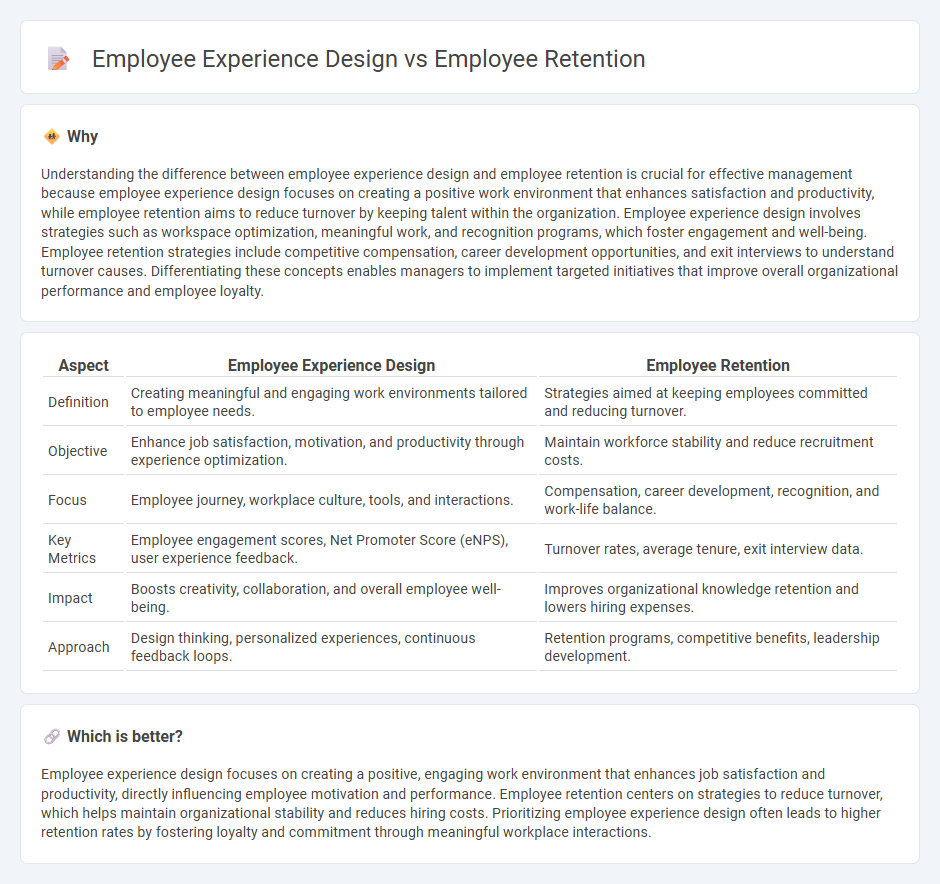
Employee experience design focuses on creating a positive, engaging workplace environment that boosts job satisfaction and productivity. Employee retention centers on strategies to keep valuable talent within the organization, reducing turnover costs and maintaining institutional knowledge. Discover how integrating both approaches enhances overall workforce stability and company performance.
Why it is important
Understanding the difference between employee experience design and employee retention is crucial for effective management because employee experience design focuses on creating a positive work environment that enhances satisfaction and productivity, while employee retention aims to reduce turnover by keeping talent within the organization. Employee experience design involves strategies such as workspace optimization, meaningful work, and recognition programs, which foster engagement and well-being. Employee retention strategies include competitive compensation, career development opportunities, and exit interviews to understand turnover causes. Differentiating these concepts enables managers to implement targeted initiatives that improve overall organizational performance and employee loyalty.
Comparison Table
| Aspect | Employee Experience Design | Employee Retention |
|---|---|---|
| Definition | Creating meaningful and engaging work environments tailored to employee needs. | Strategies aimed at keeping employees committed and reducing turnover. |
| Objective | Enhance job satisfaction, motivation, and productivity through experience optimization. | Maintain workforce stability and reduce recruitment costs. |
| Focus | Employee journey, workplace culture, tools, and interactions. | Compensation, career development, recognition, and work-life balance. |
| Key Metrics | Employee engagement scores, Net Promoter Score (eNPS), user experience feedback. | Turnover rates, average tenure, exit interview data. |
| Impact | Boosts creativity, collaboration, and overall employee well-being. | Improves organizational knowledge retention and lowers hiring expenses. |
| Approach | Design thinking, personalized experiences, continuous feedback loops. | Retention programs, competitive benefits, leadership development. |
Which is better?
Employee experience design focuses on creating a positive, engaging work environment that enhances job satisfaction and productivity, directly influencing employee motivation and performance. Employee retention centers on strategies to reduce turnover, which helps maintain organizational stability and reduces hiring costs. Prioritizing employee experience design often leads to higher retention rates by fostering loyalty and commitment through meaningful workplace interactions.
Connection
Employee experience design directly impacts employee retention by creating a work environment that enhances job satisfaction, engagement, and productivity, which reduces turnover rates. Tailoring workplace culture, career development opportunities, and feedback mechanisms addresses employees' needs and fosters loyalty. Data shows organizations with strong employee experience strategies have retention rates up to 30% higher than those without focused design initiatives.
Key Terms
Turnover Rate
Employee retention strategies aim to reduce turnover rates by fostering a supportive work environment, while employee experience design focuses on creating engaging and meaningful interactions throughout the employee lifecycle to boost satisfaction and loyalty. High turnover rates often indicate deficiencies in both retention efforts and experience design, making it crucial to integrate data-driven insights from employee feedback and performance metrics. Explore how aligning employee retention with experience design can significantly lower turnover rates and enhance organizational success.
Engagement Programs
Employee retention hinges on effective engagement programs that cultivate loyalty and reduce turnover by addressing employees' needs and aspirations. Employee experience design enhances these programs by creating tailored interactions and environments that boost satisfaction and productivity. Explore comprehensive strategies to optimize engagement programs and strengthen workforce stability.
Journey Mapping
Employee retention strategies increasingly integrate employee experience design, with journey mapping playing a pivotal role in identifying key touchpoints that influence satisfaction and engagement. By visually representing an employee's lifecycle, organizations can pinpoint pain points and opportunities for improvement, directly impacting retention rates through tailored interventions. Explore how journey mapping can transform your retention approach by enhancing employee experience design.
Source and External Links
Employee Retention - Wikipedia - Provides an overview of employee retention, including best practices such as recruitment, selection, socialization, training, and development to reduce turnover.
Employee Retention: The Real Cost of Losing an Employee - PeopleKeep - Discusses the financial impact of employee turnover and presents strategies to improve retention, including hiring the right candidates and fostering a positive culture.
What Is Employee Retention? Benefits, Tips & Metrics - NetSuite - Offers insights into the importance and benefits of employee retention, along with strategies to enhance business performance by retaining top talent.
 dowidth.com
dowidth.com